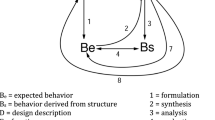Abstract
In 1998, a lead researcher at a Midwestern university submitted as his own a document that had 64 instances of strings of 10 or more words that were identical to a consultant’s masters thesis and replicated a data chart, all of whose 16 entries were identical to three and four significant figures. He was fired because his actions were wrong. Curiously, he was completely unable to see that his actions were wrong. This phenomenon is discussed in light of recent advances in neuroscience and used to argue for a change in the standard way engineering ethics is taught. I argue that engineering ethics is better taught in the form of a design course in order to maximize “somatic” learning.
Similar content being viewed by others
Notes
This case is a matter of public record. But since I am interested in the shape of Dr. M’s crime rather than his identity, I only refer to the case by its number, 1999 CV 05683. Full text of the ruling made in the Montgomery County Common Pleas Court is available online at http://www.clerk.co.montgomery.oh.us/pro/image_onbase.cfm?docket=5667438. This ruling was upheld by the Second District Court of Appeals. The appeal, Case No. 19476, is also a matter of public record: http://www.sconet.state.oh.us/rod/docs/pdf/2/2003/2003-ohio-1852.pdf (Web site accession number: 2003-Ohio-1852).
References
Basken, P. (2009). Why engineering schools are slow to change. The Chronicle of Higher Education. <http://chronicle.com/daily/2009/01/10003n.htm?utm_source=at&utm_medium=en>. Accessed 18 Mar 2009.
Bloom, B. S., et al. (Eds.). (1956). Taxonomy of educational objectives; the classification of educational goals, by a committee of college and university examiners. New York: Longmans & Green.
Bucciarelli, L. L. (1994). Designing engineers. Cambridge, MA: MIT Press.
Bucciarelli, L. L. (2002). Between thought and object in engineering design. Design Studies, 23, 219–231. doi:10.1016/S0142-694X(01)00035-7.
Bucciarelli, L. L. (2007). Workshop on philosophy and engineering. Delft: Technical University of Delft.
Damasio, A. (2005). Descartes’ error: Emotion, reason, and the human brain. London: Penguin.
Dorst, K., & Royakkers, L. (2006). The design analogy: A model for moral problem solving. Design Studies, 27, 633–656. doi:10.1016/j.destud.2006.05.002.
Ferguson, E. (1977). The mind’s eye: Nonverbal thought in technology. Science, 197, 827–836. doi:10.1126/science.197.4306.827.
Ferguson, E. S. (1993). Engineering and the mind’s eye. Cambridge, MA: MIT Press.
Gelernter, D. H. (1998). Machine beauty: Elegance and the heart of technology. New York: Basic Books.
Glenn, D. (2004). Judge or judge not. The Chronicle of Higher Education, 51, A16.
Gorringe, T. J. (2002). A theology of the built environment. Cambridge, UK: Cambridge University Press.
Kenny, A. (1976). Practical reasoning and rational appetite will, freedom and power (pp. 70–96). New York: Barnes and Noble.
Koen, B. V. (2003). Discussion of the method; conducting the engineer’s approach to problem solving. Oxford: Oxford University Press.
Kuhn, J. W. (1998). Emotion as well as reason: Getting students beyond “Interpersonal Accountability”. Journal of Business Ethics, 17, 295–308. doi:10.1023/A:1005750308801.
Lloyd, P. (2008). Designing games to teach ethics. Science and Engineering Ethics, 14, 433–447. doi:10.1007/s11948-008-9077-2.
Lloyd, P., & Busby, J. (2003). “Things that went well––no serious injuries or deaths”: Ethical reasoning in a normal engineering design process. Science and Engineering Ethics, 9, 503–516. doi:10.1007/s11948-003-0047-4.
Pugh, S. (1996). Creating innovative products using total design: The living legacy of Stuart Pugh. Reading, MA: Addison-Wesley.
Reall, M. J., Bailey, J. J., & Stoll, S. K. (1998). Moral reasoning “on hold” during a competitive game. Journal of Business Ethics, 17, 1205–1210. doi:10.1023/A:1005832115497.
Rittel, H. W. J., & Webber, M. M. (1984). Planning problems are wicked problems. In N. Cross (Ed.), Developments in design methodology (pp. 135–144). Chichester & New York: Wiley.
Schwehn, M. R. (2006). Identity, liberal education, and vocation. The Cresset Michaelmas. http://www.valpo.edu/cresset/index.html?http%3A//www.valpo.edu/cresset/2007%20Michaelmas.htm
Vincenti, W. G. (1990). Design and the growth of knowledge: The Davis wing and the problem of airfoil design, 1908–1945 what engineers know and how they know it: Analytical studies from aeronautical history (pp. 16–50). Baltimore & London: John Hopkins University Press.
Whitbeck, C. (1995). Teaching ethics to scientists and engineers: Moral agents and moral problems. Science and Engineering Ethics, 1, 299–308. doi:10.1007/BF02628805.
Whitbeck, C. (1996). Ethics as design: Doing justice to moral problems. The Hastings Center Report, 26, 9–16. doi:10.2307/3527925.
Winner, L. (1985). Do artifacts have politics? In D. MacKenzie & J. Wajcman (Eds.), The social shaping of technology: How the refrigerator god its hum (pp. 26–37). Philadelphia, PS: Open University Press.
Acknowledgements
I am very grateful to pointed criticisms and insightful additions offered on earlier drafts of this essay by my friends and gifted colleagues: Terry Tilley, Michael Cox, Kelly Johnson, Derek Hatch, Damon Martin, Herbie Miller, and Andrew Murray.
Author information
Authors and Affiliations
Corresponding author
Rights and permissions
About this article
Cite this article
Kallenberg, B.J. Teaching Engineering Ethics by Conceptual Design: The Somatic Marker Hypothesis. Sci Eng Ethics 15, 563–576 (2009). https://doi.org/10.1007/s11948-009-9129-2
Received:
Accepted:
Published:
Issue Date:
DOI: https://doi.org/10.1007/s11948-009-9129-2




